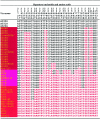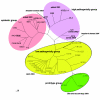Molecular evolution analysis and geographic investigation of severe acute respiratory syndrome coronavirus-like virus in palm civets at an animal market and on farms
- PMID: 16140765
- PMCID: PMC1212604
- DOI: 10.1128/JVI.79.18.11892-11900.2005
Molecular evolution analysis and geographic investigation of severe acute respiratory syndrome coronavirus-like virus in palm civets at an animal market and on farms
Erratum in
- J Virol. 2006 Aug;80(15):7786
Abstract
Massive numbers of palm civets were culled to remove sources for the reemergence of severe acute respiratory syndrome (SARS) in Guangdong Province, China, in January 2004, following SARS coronavirus detection in market animals. The virus was identified in all 91 palm civets and 15 raccoon dogs of animal market origin sampled prior to culling, but not in 1,107 palm civets later sampled at 25 farms, spread over 12 provinces, which were claimed to be the source of traded animals. Twenty-seven novel signature variation residues (SNVs) were identified on the spike gene and were analyzed for their phylogenetic relationships, based on 17 sequences obtained from animals in our study and from other published studies. Analysis indicated that the virus in palm civets at the live-animal market had evolved to infect humans. The evolutionary starting point was a prototype group consisting of three viral sequences of animal origin. Initially, seven SNV sites caused six amino acid changes, at positions 147, 228, 240, 479, 821, and 1080 of the spike protein, to generate low-pathogenicity viruses. One of these was linked to the first SARS patient in the 2003-2004 period. A further 14 SNVs caused 11 amino acid residue changes, at positions 360, 462, 472, 480, 487, 609, 613, 665, 743, 765, and 1163. The resulting high-pathogenicity groups were responsible for infections during the so-called early-phase epidemic of 2003. Finally, the remaining six SNVs caused four amino acid changes, at positions 227, 244, 344, and 778, which resulted in the group of viruses responsible for the global epidemic.
Figures





References
-
- Bi, S., E. Qin, Z. Xu, W. Li, J. Wang, Y. Hu, Y. Liu, S. Duan, J. Hu, Y. Han, J. Xu, Y. Li, Y. Yi, Y. Zhou, W. Lin, H. Xu, R. Li, Z. Zhang, H. Sun, J. Zhu, M. Yu, B. Fan, Q. Wu, W. Lin, L. Tang, B. Yang, G. Li, W. Peng, W. Li, T. Jiang, Y. Deng, B. Liu, J. Shi, Y. Deng, W. Wei, H. Liu, Z. Tong, F. Zhang, Y. Zhang, C. Wang, Y. Li, J. Ye, Y. Gan, J. Ji, X. Li, X. Tian, F. Lu, G. Tan, R. Yang, B. Liu, S. Liu, S. Li, J. Wang, J. Wang, W. Cao, J. Yu, X. Dong, and H. Yang. 2003. Complete genome sequences of the SARS-CoV: the BJ group (isolates BJ01-BJ04). Genomics Proteomics Bioinformatics 1:180-192. - PMC - PubMed
-
- Chim, S. S., S. K. Tsui, K. C. Chan, T. C. Au, E. C. Hung, Y. K. Tong, R. W. Chiu, E. K. Ng, P. K. Chan, C. M. Chu, J. J. Sung, J. S. Tam, K. P. Fung, M. M. Waye, C. Y. Lee, K. Y. Yuen, and Y. M. Lo. 2003. Genomic characterisation of the severe acute respiratory syndrome coronavirus of Amoy Gardens outbreak in Hong Kong. Lancet 362:1807-1808. - PMC - PubMed
-
- Chinese SARS Molecular Epidemiology Consortium. 2004. Molecular evolution of the SARS coronavirus during the course of the SARS epidemic in China. Science 303:1666-1669. - PubMed
-
- Guan, Y., J. S. Peiris, B. Zheng, L. L. Poon, K. H. Chan, F. Y. Zeng, C. W. Chan, M. N. Chan, J. D. Chen, K. Y. Chow, C. C. Hon, K. H. Hui, J. Li, V. Y. Li, Y. Wang, S. W. Leung, K. Y. Yuen, and F. C. Leung. 2004. Molecular epidemiology of the novel coronavirus that causes severe acute respiratory syndrome. Lancet 363:99-104. - PMC - PubMed
Publication types
MeSH terms
Substances
Associated data
- Actions
- Actions
- Actions
- Actions
- Actions
- Actions
- Actions
- Actions
- Actions
- Actions
- Actions
- Actions
- Actions
- Actions
- Actions
- Actions
- Actions
- Actions
Grants and funding
LinkOut - more resources
Full Text Sources
Other Literature Sources
Miscellaneous

